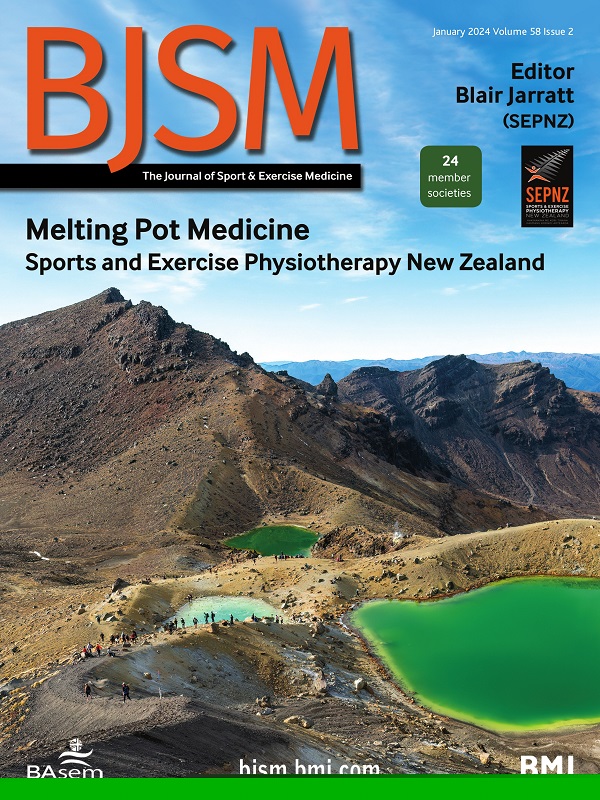Prevention strategies and modifiable risk factors for spine, chest, abdominal and/or pelvic injury and pain: a systematic review and meta-analysis for the Female, woman and girl Athlete Injury pRevention (FAIR) consensus
IF 16.2
1区 医学
Q1 SPORT SCIENCES
引用次数: 0
Abstract
Objective Investigate prevention interventions and potential modifiable risk factors (MRFs) for female/woman/girl athletes’ spine, chest, abdominal or pelvic injury and/or pain. Design Systematic review with meta-analyses, semiquantitative analyses and Grading of Recommendations Assessment, Development and Evaluation. Data sources MEDLINE, CINAHL, APA PsycINFO, CDSR, CENTRAL, SPORTDiscus, EMBASE, ERIC. Eligibility Primary data studies with comparison group(s) assessing the association of prevention interventions and/or MRFs for spine, chest, abdominal and/or pelvic injury/pain with ≥1 female/woman/girl athlete in each study group. Results Across 105 studies (n=11 interventions, n=92 MRFs, n=2 both, n=35 female/woman/girl-specific estimates) including 59 833 participants (23.7% females/women/girls) 9 injury/pain outcomes were assessed (n=74 low-back, n=14 back, n=13 neck, n=5 pelvis, n=3 thoracic, n=3 abdominal, n=3 trunk, n=2 rib, n=1 breast). Three prevention strategies (exercise, equipment, rule-change) and 22 MRFs were identified. High risk of confounding bias (Downs and Black quality assessment tool) was present in 92% and 63% of intervention and MRF studies, respectively. Considering female/woman/girl estimates, we performed meta-analyses (standardised mean-difference) on 4 MRFs (body mass, body mass index (BMI), weekly training hours, spinal flexion) for low-back pain (LBP) and semiquantitative analyses for one intervention (exercise), and 3 MRFs (yearly training load, hip motion, hip strength) for LBP. Very low-certainty evidence suggests no difference in body mass (g=0.28, 95% CI −0.06 to 0.62; I2=67.7%), BMI (g=0.22, 95% CI −0.25 to 0.69; I2=68.2%), weekly training hours (g=0.15, 95% CI −0.29 to 0.58; I2=45.6%) or spinal flexion (g=0.27, 95% CI −0.23 to 0.76; I2=40.4%) between female/women/girls athletes with and without LBP. Conclusions There is limited knowledge about prevention interventions or MRFs for female/women/girl athletes’ spine, chest, abdominal and/or pelvic injury/pain. PROSPERO registration number CRD42024479654. Data are available on reasonable request. Deidentified data can be made available on reasonable request to the corresponding author. Please email the corresponding author with a written proposal outlining the specific research aims and analysis plan and why these specific data are needed. A formal data-sharing agreement between institutions will be required.脊柱、胸部、腹部和/或骨盆损伤和疼痛的预防策略和可改变的危险因素:对女性、女性和女孩运动员损伤预防(FAIR)共识的系统回顾和荟萃分析
目的探讨女/女/女运动员脊柱、胸部、腹部或骨盆损伤和/或疼痛的预防干预措施和潜在可改变的危险因素(mrf)。设计采用meta分析、半定量分析和建议评估分级的系统评价。数据来源:MEDLINE, CINAHL, APA PsycINFO, CDSR, CENTRAL, SPORTDiscus, EMBASE, ERIC。主要资料研究与对照组的研究,评估预防干预和/或脊柱、胸部、腹部和/或骨盆损伤/疼痛的磁共振成像与每个研究组中≥1名女/女/女运动员的关联。在105项研究中(n=11项干预措施,n=92项磁共振成像,n=2项,n=35项女性/女性/女孩特异性估计),包括59833名参与者(23.7%女性/女性/女孩),评估了9种损伤/疼痛结局(n=74例腰背部,n=14例背部,n=13例颈部,n=5例骨盆,n=3例胸部,n=3例腹部,n=3例躯干,n=2例肋骨,n=1例乳房)。确定了三种预防策略(锻炼、装备、规则改变)和22种mrf。高混杂偏倚风险(Downs和Black质量评估工具)分别存在于92%和63%的干预和MRF研究中。考虑到女性/女性/女孩的估计,我们对腰痛(LBP)的4个mrf(体重、体重指数(BMI)、每周训练时间、脊柱屈曲)进行了荟萃分析(标准化平均差异),对一项干预(运动)进行了半定量分析,对LBP的3个mrf(每年训练负荷、髋关节运动、髋关节力量)进行了半定量分析。极低确定性证据表明,有和没有腰痛的女/女/女运动员在体重(g=0.28, 95% CI−0.06至0.62;I2=67.7%)、BMI (g=0.22, 95% CI−0.25至0.69;I2=68.2%)、每周训练时间(g=0.15, 95% CI−0.29至0.58;I2=45.6%)或脊柱屈曲(g=0.27, 95% CI−0.23至0.76;I2=40.4%)方面没有差异。结论对女/女/女童运动员脊柱、胸部、腹部和/或骨盆损伤/疼痛的预防干预或磁共振成像的了解有限。普洛斯彼罗注册号CRD42024479654。如有合理要求,可提供资料。应通信作者的合理要求,可以提供未识别的数据。请给通讯作者发一份书面提案,概述具体的研究目的和分析计划,以及为什么需要这些具体的数据。各机构之间需要签署正式的数据共享协议。
本文章由计算机程序翻译,如有差异,请以英文原文为准。
求助全文
约1分钟内获得全文
求助全文
来源期刊
CiteScore
27.10
自引率
4.90%
发文量
217
审稿时长
3-8 weeks
期刊介绍:
The British Journal of Sports Medicine (BJSM) is a dynamic platform that presents groundbreaking research, thought-provoking reviews, and meaningful discussions on sport and exercise medicine. Our focus encompasses various clinically-relevant aspects such as physiotherapy, physical therapy, and rehabilitation. With an aim to foster innovation, education, and knowledge translation, we strive to bridge the gap between research and practical implementation in the field. Our multi-media approach, including web, print, video, and audio resources, along with our active presence on social media, connects a global community of healthcare professionals dedicated to treating active individuals.

 求助内容:
求助内容: 应助结果提醒方式:
应助结果提醒方式:


